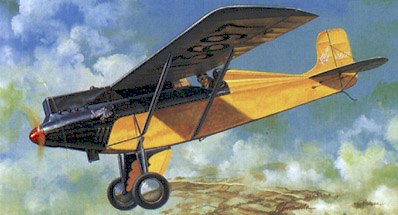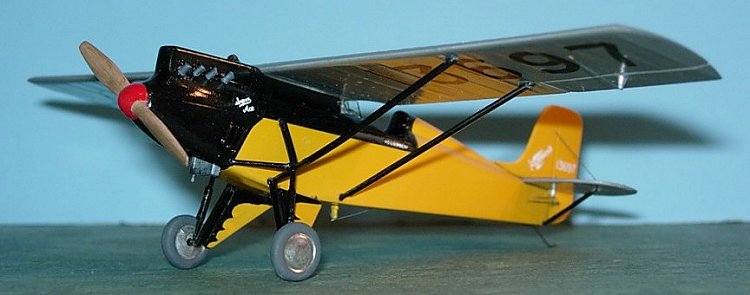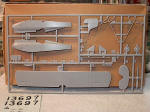
| KIT: | William Bros. 1/48 Corben Super Ace |
| KIT #: | 48-3191 |
| PRICE: | $9.95 |
| DECALS: | One option |
| REVIEWER: | Michael Stanley |
| NOTES: | Unique 'Golden Age' Homebuilt |

| HISTORY |

During 1935, Popular Aviation magazine published a series of articles concerning this attractive single-seat sportplane intended for construction by amateurs. A Ford Model A engine was used for power, and it too was the subject of an article describing modifications and need accessories.
The Super-Ace was designed by Orlan G. Corben, who had also produced other sportplanes such as the Baby-Ace and Junior-Ace, praiseworthy for simplicity and economy. The Super-Ace incorporated similar straight-forward construction philosophy combined with readily available low-cost materials. Its exciting appearance and spirited performance made the Super-Ace an intriguing proposition, as did the dramatic full-color painting by Herman R. Bollin, printed on the April, 1935 Popular Aviation front cover.
 The same issue
featured a charming rubber-powered stick-and-tissue flying model of the
Super-Ace by Paul W. Lindberg, famous in his own right as a model designer.
By September of that year, the Imperial Model Aero Supply Company of
Brooklyn, New York, was advertising a 36-inch wingspan Super-Ace kit.
The same issue
featured a charming rubber-powered stick-and-tissue flying model of the
Super-Ace by Paul W. Lindberg, famous in his own right as a model designer.
By September of that year, the Imperial Model Aero Supply Company of
Brooklyn, New York, was advertising a 36-inch wingspan Super-Ace kit.
Over the years, other models, ranging from tiny wooden “solids” to large radio-controlled examples, have helped keep the Super-Ace familiar to legions of aviation enthusiasts. This seems appropriate, because Orlan Corben himself had been a model builder.
Lightplane authority John Underwood estimates that at least six full-size Super-Aces were constructed, four of them prior to 1940.
SPECIFICATIONS: The prototype Super-Ace spanned 25 feet, but according to its designer extra area was added “in favor of the fellows who live in high altitudes.” The span addition amounted to two feet, although slight variations exist in published dimensions. Wing Span: 27’ 3 ½”. Weight (empty): 569 pounds.
CONSTRUCTION: Fuselage and tailplanes: welded steel tubing and sheet metal. Wings: spruce spars and built-up wooden ribs Covering: fabric, except for sheet metal cowling areas.
 ENGINE DATA:
Modified Ford Model A automobile powerplant. Maximum RPM: 2000 Weight 219
pounds
ENGINE DATA:
Modified Ford Model A automobile powerplant. Maximum RPM: 2000 Weight 219
pounds
PERFORMANCE: Top speed: 100 mph Cruising speed: 85 MPH
Landing speed: 32 MPH Take-off run: 200 feet
Economy: 25 miles per gallon
Not too shabby, even by today’s standards!
| THE KIT |
 This
kit is one of quite a few very unique aircraft produced by Williams
Brothers in San Marco, California. Williams Brothers is probably one of the
original US makers of what we now call “short-run” kits. Their catalogue
covers many racing aircraft from the Golden Age of aviation in the 1930’s.
When I started this project I sent them an email requesting the original
release date of this kit, but never got a reply. From the dates on the
references provided on the instruction sheet, I would say that this kit was
released in the mid to late 1980’s.
This
kit is one of quite a few very unique aircraft produced by Williams
Brothers in San Marco, California. Williams Brothers is probably one of the
original US makers of what we now call “short-run” kits. Their catalogue
covers many racing aircraft from the Golden Age of aviation in the 1930’s.
When I started this project I sent them an email requesting the original
release date of this kit, but never got a reply. From the dates on the
references provided on the instruction sheet, I would say that this kit was
released in the mid to late 1980’s.
About 2 years ago I built the 1/32 F9C Sparrowhawk and found it built up well but had quite a bit of flash on the rather soft white plastic. With the Corben kit I was pleasantly surprised to find that the grey plastic was very similar to Hasegawa or Tamiya kits with almost no flash. The sprue injection gates are kind of large but trim very easily with a sharp scalpel and a touch with a sanding stick.
| CONSTRUCTION |
As I am sure many of you do, I began this build with a “google” on the internet to pique my interest about this little cutie. I also wanted to see what was available in after-market parts and decals. Well, google doesn’t turn up much as far as history. In fact, there are more “hits” of this airplane as a model than as a real homebuilt. There are quite a few large r/c and free-flight models available, probably because it was designed to be a very stable flyer. And after-market – “fuggidaboudit”.
My
research showed this little guy never had mottle or swastikas. Because of
this, Tamiya or Hasegawa are pro bably not going to produce a 1/48th
release in what is now called “state of the art”, so I just dove in!
Removing the parts from the trees took only a few minutes and about 45
seconds of sanding on a piece of 600 grit on a piece of mirror and I had a
fuselage that fit as well as anything from the big guys. The wing is one
piece so you don’t even have to worry about filling a join line there. The
wing struts need some attention to sand off the mold lines, but once again
this only takes a few minutes.
bably not going to produce a 1/48th
release in what is now called “state of the art”, so I just dove in!
Removing the parts from the trees took only a few minutes and about 45
seconds of sanding on a piece of 600 grit on a piece of mirror and I had a
fuselage that fit as well as anything from the big guys. The wing is one
piece so you don’t even have to worry about filling a join line there. The
wing struts need some attention to sand off the mold lines, but once again
this only takes a few minutes.
According
to the instructions the interior color was “unknown” but light gray is
recommended. Since the real plane was
![]() fabric covered I opted to go with Floquil “Antique White” which would be the color of the unpainted fabric on
the inside. I also highlighted the internal struts with some Floquil
gunmetal to simulate the steel tubing structure. The “ejection seat” is
gloss black and the kit decal is used for the instrument panel.
fabric covered I opted to go with Floquil “Antique White” which would be the color of the unpainted fabric on
the inside. I also highlighted the internal struts with some Floquil
gunmetal to simulate the steel tubing structure. The “ejection seat” is
gloss black and the kit decal is used for the instrument panel.
At this point I also pre-drilled all the holes for the control runs. When doing this I try to approximate the exit angle of the real line because the invisible thread that I use for rigging sometimes doesn’t bend well coming out of 90 degree holes.
| COLORS & MARKINGS |
Once the fuselage was assembled I stuffed the cockpit with some high density foam and wiped everything down with rubbing alcohol before the colors. Once you look at the paint scheme you will see that it is much easier to paint the separate pieces than to go the usual route of painting after major assembly. I hit the wings and stabilizer with Floquil Old Silver enamel thinned about 50% with lacquer thinner. Then the fuselage, fin and strut fairings with Floquil “Reefer Yellow” (For you young whippersnappers in the audience “reefer yellow” and “reefer white” are not what we children of the 60’s painted our funny cigarettes. These colors refer to the color of “refrigerated” railcars. My grandfather worked on the Union Pacific ice docks in the 1930’s where these cars were loaded with ice.)
 I then
masked the fuselage off for the black trim and hit it and the various
struts with Floquil CSX Black. (Can you tell I like Floquil paint?) Once
the old silver had dried for about 2 days I began the assembly. It sure
doesn’t take long! Just be careful with your Mk I eyeball and maybe some
drafting dividers to get everything lined up. You need to pause after the
wings are on to apply the registration numbers to the wings before gluing
on the wing struts. About this time I got a little stumped by the scallops
on the wheel fairings. Remember, this little guy never had mottle so there
are no decals available. I futzed around for a while with some computer
graphics programs but finally just made a paper “mask” with a ruler and a
hole template then “free-handed” them in with the CSX black.
I then
masked the fuselage off for the black trim and hit it and the various
struts with Floquil CSX Black. (Can you tell I like Floquil paint?) Once
the old silver had dried for about 2 days I began the assembly. It sure
doesn’t take long! Just be careful with your Mk I eyeball and maybe some
drafting dividers to get everything lined up. You need to pause after the
wings are on to apply the registration numbers to the wings before gluing
on the wing struts. About this time I got a little stumped by the scallops
on the wheel fairings. Remember, this little guy never had mottle so there
are no decals available. I futzed around for a while with some computer
graphics programs but finally just made a paper “mask” with a ruler and a
hole template then “free-handed” them in with the CSX black.
Since you can’t call yourself a real modeler today without using some aftermarket stuff I had to do something. The kit exhaust stacks are nice but really need to be drilled out. To show I am a real man I went to the drug store and bought the cheapest q-tips I could find with plastic sticks. Then I carefully heat stretched them to the right diameter and sliced off some exhausts. Voila! No longer out of the box! What little rigging there is can be done quickly with some invisible thread and CA glue. Other final stuff was grimy black for the tires and some old Testors Pla tan followed by a light dry brush of darker brown on the prop. A final “wash” of the radiator with some black water color and she was done.
| CONCLUSIONS |
A very colorful little piece of aviation history for 10 bucks. I can’t imagine what the FAA would say today about someone tootling around the countryside behind a 1930’s Model A engine! Highly recommended, along with most of the other Williams Brothers kits for those interested in the “forgotten” age of aviation.
September 2004
| REFERENCES |
“google” and the kit instructions
Visit Michael's IPMS gang at http://www.percongrp.com/pelikan.htm
If you would like your product reviewed fairly and quickly by a site that has over 250,000 visitors a month, please contact me or see other details in the Note to Contributors.